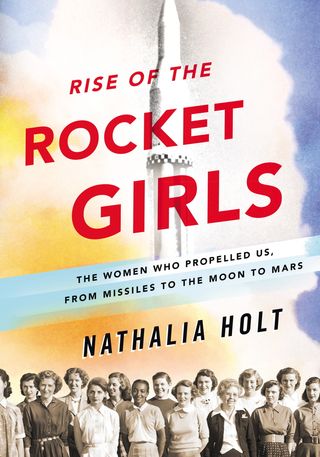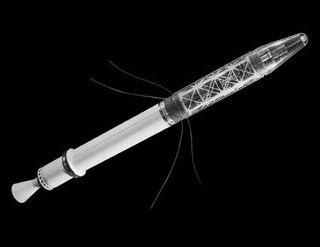'Rise of the Rocket Girls' Tells the Stories of NASA's Women Pioneers

Missile and rocket technology from the California-based Jet Propulsion Laboratory (JPL) has propelled American spaceflight for decades, and from the beginning that technology's success rested on a corps of expert mathematicians — women who crunched the numbers, plotted rocket trajectories and tested rocket designs, all on paper.
Drawing from extensive interviews, Nathalia Holt's "Rise of the Rocket Girls: The Women Who Propelled Us, from Missiles to the Moon to Mars" (Little, Brown and Co., 2016) traces the history of spaceflight through those women's eyes, highlighting the fledgling lab's rocket tests in the 1940s; the United States' first orbiting satellite, Explorer 1; and the many craft flung outward to first explore our solar system. At the same time, it shows the rise and evolution of female mathematicians and, eventually, engineers — and the changing cultures that working women had to navigate at that time.
Editor's note: Holt will be in Washington, D.C., on April 20 at 6:30 p.m. EDT for the first "It's Science! With Politics & Prose and Space.com" event, which is free and open to the public. See the Politics & Prose calendar for details.
Space.com talked with Holt about how the story came together, the process of tracking down the female mathematicians and what made JPL's environment so unique. Read an excerpt from the book here; Holt discusses tracking down the women's stories in an essay here.
Space.com: How did you first find out about the women you cover in your book?

Nathalia Holt: It is an unusual way to come across a book topic like this, but it started in 2010. My husband and I were expecting our first child, and we were just having a horrible time coming up with names; it was very difficult for us. And we finally thought of "Eleanor Frances." So we Googled the name — which is what you do these days to see who else in history might have the name — and the first name that came up was a woman named Eleanor Frances Helin. There was this really lovely picture of her, and [in the photo], she's accepting an award at NASA. And it struck me, because I didn't realize that women had worked at NASA during that time, much less as scientists. And so I started to look more into her.
What I found out is that she's actually just one of many women who were working there at the time and even earlier. So there was this very large group of women who were working as "computers," and this started in the 1940s. Of course, this ["computers"] is a weird name to call someone. But it's not like the digital devices we have today — these were human beings that had to do all the calculations. [Space History Photo: JPL's Space Flight Operations Facility]
Get the Space.com Newsletter
Breaking space news, the latest updates on rocket launches, skywatching events and more!
Space.com: Was it hard to track down the sources you ended up talking with for the book?
Holt: It was very difficult. One thing that I thought was sad with the book is that, when I first started researching it, I would get these lovely pictures from the archives at the Jet Propulsion Laboratory in Pasadena, and they'd be wonderful pictures showing the women working in the 1940s, 1950s — but the captions would only ever have very few names. And they didn't have any contact information for these women. So it was quite a lot of work to find them. [I] ended up just calling dozens and dozens of women. And I like to joke that, if your name is Barbara or Helen or Virginia, it's very possible that I've called you, because I've just called so many. But once I did find the right ones, it was a thrilling moment, because the women were just so excited to have their stories told and to talk to me. They're also quite close friends today, so once I found a few, it became quite easier to find the whole group.

Space.com: What was it like talking with them?
Holt: From the beginning, it was so exciting to hear these stories firsthand, to hear what it was like in mission control during Explorer 1, America's first satellite, and [the solar-system-touring] Voyager — to hear those memories of what it was like to actually see the images when they were first being streamed back and imagine what that moment was like with everyone packed into the auditorium. There are so many moments in history that I really felt so privileged to be able to hear and to be able to experience, in a way, through those interviews. [How NASA's Voyager 1 and 2 Probes Work (Infographic)]
And then, there were also some wonderful moments in their personal lives as well. I tried to combine that in the book, because what they did is not important just scientifically, but it also has cultural importance, because so few women were working outside of the home at that time, especially mothers. This is a group of women who defied these cultural norms. In 1960, only 25 percent of mothers worked outside the home. And so you have this wonderful story of what they were able to accomplish scientifically, but also fun stories about how they were able to work all night in mission control, and spend days in the lab, while juggling their families, too.
Space.com: What did you find most surprising while researching the book?
Holt: One of the most surprising things, to me, was the lack of recognition, as strange as it seems. I was really surprised — they had this big party for Explorer 1's 50th anniversary at JPL, and of all the people that came, they didn't invite the women that were there that night that were such a vital part of that operation. This book really celebrates what a wonderful place JPL is, but this is one area that I do think is very sad: that these women haven't gotten the recognition, and haven't really been celebrated for their contributions to NASA.

The longevities of their careers are very different than you see at other NASA centers, and I think much of that can be attributed to the men that they worked with. And they also have wonderful stories about what these missions were like, and I wish I could have put more of those details in there.
Space.com: What was your favorite moment of NASA history to write about?
Holt: There are so many; it's hard. Writing about Voyager was probably my favorite moment, because it is just so exciting. That's probably the one moment that, if I could transport myself back into time, that's the place that I'd love to go. It must have been so exciting to have all the members of the lab camped out, just waiting days during these flybys, so excited to see these first pictures that were so close up of other planets — I can't even imagine how exciting that must have been.
Email Sarah Lewin at slewin@space.com or follow her @SarahExplains. Follow us @Spacedotcom, Facebook and Google+. Original article on Space.com.
Join our Space Forums to keep talking space on the latest missions, night sky and more! And if you have a news tip, correction or comment, let us know at: community@space.com.

Sarah Lewin started writing for Space.com in June of 2015 as a Staff Writer and became Associate Editor in 2019 . Her work has been featured by Scientific American, IEEE Spectrum, Quanta Magazine, Wired, The Scientist, Science Friday and WGBH's Inside NOVA. Sarah has an MA from NYU's Science, Health and Environmental Reporting Program and an AB in mathematics from Brown University. When not writing, reading or thinking about space, Sarah enjoys musical theatre and mathematical papercraft. She is currently Assistant News Editor at Scientific American. You can follow her on Twitter @SarahExplains.
Most Popular

